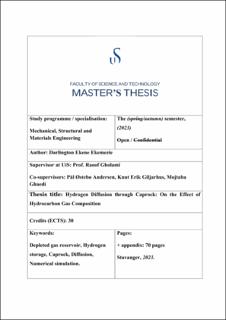| dc.description.abstract | Hydrogen storage in a depleted gas reservoir can be one of the most reliable options for seasonal, long-term, and large gigatons volume storage. Hydrogen loss due to molecular diffusion into caprock is one of the concerns of underground hydrogen storage in depleted gas reservoirs. This study evaluated the significance of hydrogen loss into caprock resulting from molecular diffusion. In particular, the impacts of pre-defused hydrocarbons inside the caprock were investigated.
For this purpose, one-dimensional models were created, and a numerical simulation of hydrogen diffusion was performed using ECLIPSE 300. Moreover, chemical potential was used as the driving force for hydrogen diffusion and the model was assumed to have some previously diffused hydrocarbon components in the caprock. The fluid properties were modelled using the Peng-Robinson equation of state and the dissolution of gas in the water that occupies the pores of the caprock was neglected.
The results showed that the pre-defused hydrocarbons in the caprock influence the concentration and hence the cumulative loss of the hydrogen being diffused through the pores of the caprock. Other reservoir storage factors like pressure, temperate, and porosity also play a vital role in this process. The hydrocarbons have been observed to limit the rate of diffusion into the caprock as the simulation goes from less dense to denser with respect to the pressure and temperature applied. Multiple gases of hydrocarbons also showed to limit cumulative loss to caprock at very low temperatures and high pressure. The gas composition at the boundary influences the caprock and reservoir interaction. Over time, the concentration value of hydrogen in the caprock in reservoir conditions indicates that hydrogen molecules will readily diffuse into the pores of the caprock.
The results also showed that hydrogen loss has a direct relationship with the porosity of the caprock, the gas saturation of the caprock, the square root of the diffusion coefficient, and the square root of time. | |
